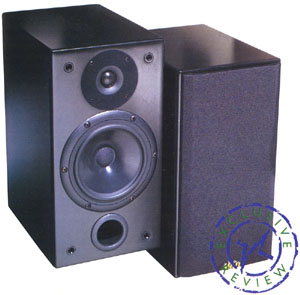
JUNE 2000

Not so small by UK standards, this 'baby' American speaker sounds bigger than it looks
by IVOR HUMPHREYS
 Alón is the primary brand name of New Jersey-based loudspeaker
manufacturer Acarian Systems, which made its debut at the January 1992
CES in Las Vegas with its Alón IV design. The man behind it is
Carl Marchisotto, formerly chief designer at Dahlquist. There are
currently 15 models in the Acarian catalogue: five open baffle types,
two conventional cabinet designs in a 'wood monitor' series, three
'minimonitors' of which the £425 Li'l Rascal is the smallest,
three hi-fi subwoofers and two home cinema units, the Centris and
Centris Sub.
Alón is the primary brand name of New Jersey-based loudspeaker
manufacturer Acarian Systems, which made its debut at the January 1992
CES in Las Vegas with its Alón IV design. The man behind it is
Carl Marchisotto, formerly chief designer at Dahlquist. There are
currently 15 models in the Acarian catalogue: five open baffle types,
two conventional cabinet designs in a 'wood monitor' series, three
'minimonitors' of which the £425 Li'l Rascal is the smallest,
three hi-fi subwoofers and two home cinema units, the Centris and
Centris Sub.
On this side of the pond we'd call the Rascal a medium sized loudspeaker rather than a minimonitor, standing as it does 394mm (15.5in) high, but it is certainly compact. It is a two-way design intended for two-channel stereo and/or home cinema applications, for which purpose it has magnetically shielded drive units, allowing use near a monitor or television.
The 165mm bass/midrange driver is newly developed and claims sophisticated voice-coil technology which helps reduce distortion and assist power handling. It is built into a substantial moulded plastics chassis, has a convex rubber roll surround and a stiff woven fabric dustcap. The 25mm silk-dome tweeter is also new and has an integral flared horn formed by its faceplate. Both drivers are through-mounted on the baffle, the LF standing slightly proud on its rounded bezel, the tweeter set flush with its faceplate covered in felt, presumably to help control diffraction. Reflex loading for the bass is provided by a gently flared tubular port which is a friction fit in the front baffle.
The crossover caters only for a normal two-wire feed (i.e., it is not bi-wirable). A simple circuit, it employs two air-cored chokes, two polypropylene film capacitors and three resistors and is point-to-point wired on a hardboard former. Gold-plated input terminals cater for 4mm plugs, bare wire ends or spade terminals. The screw heads have flats inviting use of a spanner, though you'd need to be careful not to disturb the pin fixings.
The cabinet is made of 18mm thick medium density fibreboard (MDF) with all 12 edges mildly radiused. No internal bracing is used but damping is achieved with a loose block of fibrous wadding which runs the height of the void and is placed diagonally from one front edge to its opposite at the rear. Finish is normally black paint or 'solid' cherry, though other colours are apparently available. The drive units are normally hidden by a simple open MDF frame covered in a stretch open-weave fabric. I thought the sound better with it removed, though the difference is subtle.
A simple impedance check confirmed the nominal 8 ohms load, with the minimum value comfortably above the 6 ohms claimed. The usual twin impedance peaks occurred at around 25Hz and 80Hz, with a further one at just over 2kHz. Sensitivity is specified at 88dB spl for 2.83V at 1m and the frequency range 55Hz-20kHz (within ±2-5dB from 60Hz upwards).
The Rascal is intended to be placed at least 12in away from the rear and 36in from the side walls. The mid-point between its drivers' axes should fall at about the ear height of a seated listener, which implies stands about 24in high. I used the neat single-column HS60II from Target, which I normally use with a pair of the genuinely diminutive AVI NuNeutrons.
This is an eminently listenable loudspeaker possessed of a surprisingly smooth tonal balance and quite excellent dynamic capability. It seems suited to all kinds programme material, from solo piano, solo vocal and chamber music to full orchestral, jazz and rock.
To be honest I'd not expected to be so impressed since a knuckle test on the cabinet led me to anticipate significant coloration. There is indeed some emphasis at around 250Hz (and again, though less, at 380Hz) which adds 'warmth' to the middle of the piano register, but it is quite mild and I was very pleasantly surprised at the unaffected naturalness of solo baritone and soprano, and indeed of unaccompanied choir - severe tests for any loudspeaker.
A key part of the Rascal's success, I think, ties in its crisp dynamic response: it 'speaks' well across the audio band and the obviously good integration of its drivers allows it to generate a very plausible, sharply defined sound stage. There's little tendency to compression either, even in substantial orchestral climaxes. And the bass isn't at all bad -reasonably extended for a modest box and not in the least sluggish.
All in all I consider this modest design first rate value for money. It is easy to drive and would complement modest ancillaries to winning effect. But it could happily sit in fairly elevated company too. It's not without 'character' but has far more the manners of a lucky rascal than those of a knavish rogue.